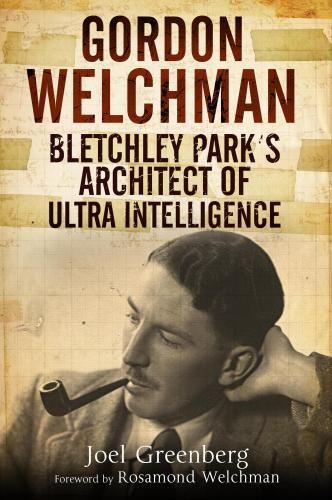| Title: | Gordon Welchman - Bletchley Park’s architect of Ultra intelligence |
| Author: | Joel Greenberg |
| Editor: | Frontline Books, an imprint of Pen & Sword Books Ltd. |
| Published: | 2014 |
| Pages: | 286 |
| ISBN: | 9781848327528 |
| Review: |
This biography starts with a foreword by Rosamond Welchman the daughter of the mathematician Gordon Welchman, (1906 – 1985) who, just like her brother till the seventies never heard from her father about his activities during World War Two. Because other writers published books like "The Ultra Secret" by Frederick Winterbotham in 1974, Anthony Cave Brown’s "Bodyguard of lies" and Ronald Lewin with his "Ultra goes to war" in 1975, Welchman did not feel so strictly committed to the "Officials Secrets Act" anymore and did he lift some of the veils that still clung to Bletchley Park as the decipher centre with his book "The Hut Six Story". Hut 6 on mansion Bletchley Park formed the production section and its sub divisions followed Welchman’s plan for a production-line approach.
The book provides a detailed account of the acquisition of the mansion in 1938 and the subsequent expansion with the various wooden structures which were all identified with a Hut number. The intercepted German army and air force messages were decrypted in Huts 6 and 3; the navy messages (which were encrypted with a different Enigma machine) in Huts 8 and 4. The reason that several of these annexes were constructed in high tempo was, that Welchman may be called the architect of the ‘production line’ of the deciphered messages. He recruited his staff from his former school friends from Marlborough and students from Cambridge where he lectured algebraic geometry till 1939. He set up good connections with the interception centres and developed an organigram in order to make Bletchley Park to operate as a streamlined organisation. Co-scientist Alan Turing, probably the most well-known code breaker of Bletchley Park, developed a machine which would become the predecessor of the computer and which has been designated the "Bombe" in this biography (derived from the word Bomba in Polish). This machine was developed in order to produce a systematic analysis of decrypted messages. Bletchley Park expert, Joel Greenberg, who was able to consult the ‘treasure trove’ of material that had been stored at the loft of the house of the son of Gordon Welchman, describes in a lively manner how Welchman started to see a pattern in the hundreds of intercepted messages (per day) from the German army and air force. By the formal use of language between the units this provided a deep insight in positions of German commanders, the command structures and the various aspects of the military operations. The large contribution of Welchman is the structuring of the deciphering, the translation and the analysis. In 198 pages the book describes in detail the rather turbulent life of Gordon Welchman, for example he married three times, worked for the NSA in the USA, lectured in a newly established study centre (still) called "The MITRE Institute" which introduced around 1958 educational methods for system engineering in the field of communication. On page 200, Appendix 1 starts: "A Beginner’s Guide to Enigma and the Bombe". At the hand of designs, schemes, and drawings, the working of the German decrypting machines has been explained. It will require some mathematical back ground to understand this part of the book. Appendix 2 continues with " Enigma and the Bombe in Depth". As the title announces, this is almost a practical instruction with cipher and letter series, diagrams and formulas for the Enigma machines and the mathematical code breaking analyses which were made of the intercepted messages. Appendix 3 "A Comedy of Errors" refers again to "The Hut Six Story" with which Welchman describes the mistakes made by the Germans while using the Enigma, but certainly also the mistakes made by the designers of the Enigma with which Hut 6 had to deal and those who were responsible for laying down the operating procedures, the scientists who (miss) communicated about those and errors made by the cipher clerks who operated the machines. The machine would have been perfect if it had been used properly. In other words, Welchman also does not spare himself if everything had not been used to its ultimate perfection. Appendix 4 provides a listing of all decoded German keys and the unit where these belonged, as well as the dates on which they were used for the first and the last time. Appendix 5 is a photocopy of the letter from the director of the Government Communications Headquarters with which he warns Welchman that an additional publication on his already loathed editing of "The Hut Six Story" means a serious breach of his obligations of the Official Secrets Act. And that it is a serious disappointment to them and his ex-colleagues and damages the security issues. Appendix 6 lists Welchman’s publications. Thereafter the biography has been rounded off with the usual Notes divided per chapter, a Bibliography and finally an Index with reference to names and facts in the book. It is a well-founded study of the person and the subjects that kept him engaged both during the war years and thereafter. As said before, the explanation of the Enigma and the Bombe demand a certain educational background, but for the determined code experts and the curious of this subject it is a gold mine of information. |
| Rating: |
|
Information
- Article by:
- Fred Bolle
- Published on:
- 10-12-2014
- Feedback?
- Send it!




